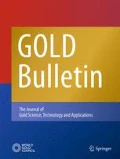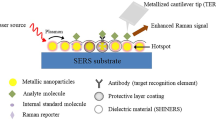Abstract
Golden inverse opals additionally decorated with 15.5 ± 1.5 nm gold nanoparticles are proposed as reusable substrates for surface-enhanced Raman spectroscopy (SERS). Gold nanoparticles are found to be uniformly distributed making an input of enhancement ability of spectral characteristics with the colloidal system by ten times. This technique is demonstrated to be efficient in spectral features tuning via a combination of different gold derivatives. Two lasers served for resonant, pre-resonance, and non-resonance signal analyses. Reusability of the Au-Au composite films is demonstrated for methylene blue as a stable dye deposited onto the SERS chips using a 632.8-nm resonant laser for exciting. The enhancement factor for methylene blue achieved 108 and for rohodamine 6G was of about 105. It was observed that rinsing of Au-Au nanocomposite SERS films with distilled water and heating up to 100 °C followed by dropping on a new portion of Au colloids onto the platform regenerates the substrates.








Similar content being viewed by others
References
Grigoriev SV, Napolskii KS, Grigoryeva NA, Vasilieva AV, Mistonov AA, Chernyshov DY, Petukhov AV, Belov DV, Eliseev AA, Lukashin AV, Tretyakov YD, Sinitskii AS, Eckerlebe H (2009) Structural and magnetic properties of inverse opal photonic crystals studied by X-ray diffraction, scanning electron microscopy, and small-angle neutron scattering. Phys Rev B 79(045123):1–8
Wang D, Salgueiriño-Maceira V, Liz-Marzán LM, Caruso F (2002) Gold–silica inverse opals by colloidal crystal templating. Adv Mater 14(12):908–912
Grunin AA, Sapoletova NA, Napolskii KS, Eliseev AA, Fedyanin AA (2012) Magnetoplasmonic nanostructures based on nickel inverse opal slabs. J Appl Phys 111:07A948
Wilson PM, Mbah GN, Smith TG, Schmidt D, Lai RY, Hofmann T, Sinitskii A (2014) Three-dimensional periodic graphene nanostructures. J Mater Chem C 2:1879–1886
Kim S, Mitropoulos AN, Spitzberg JD, Tao H, Kaplan DL, Omenetto FG (2012) Silk inverse opals. Nat Photonics 6:818–823
Tan Y, Qian W, Ding S, Wang Y (2006) Gold-nanoparticle-infiltrated polystyrene inverse opals: a three-dimensional platform for generating combined optical properties. Chem Mater 18:3385–3389
Yang X, Shi C, Newhouse R, Zhang JZ, Gu C. (2011) Hollow-core photonic crystal fibers for surface-enhanced Raman scattering probes. Int J Optics, Article ID 754610. https://doi.org/10.1155/2011/754610
Martynova NA, Goldt AE, Maslakov KI, Savilov SV, Grigorieva AV (2018) Electroplating of porous gold films for SERS analysis of Heme derivatives. J Mater Sci 53:7953–7962
Wang X, Shao M, Zhang S, Liu X (2013) Biomedical applications of gold nanorod-based multifunctional nano-carriers. J Nanopart Res 15(1892):1–16
Moskovits M (2013) Persistent misconceptions regarding SERS. Phys Chem Chem Phys 15:5301–5311
Polyakov AY, Nesterov AV, Goldt AE, Zubyuk V, Dolgova T, Tenne R, Goodilin EA (2015) Optical properties of multilayer films of nanocomposites based on WS2 nanotubes decorated with gold nanoparticles. J Phys: Conf Series 643:012046
Hashmi ASK, Hutchings GJ (2006) Gold catalysis. Angew Chem Int Ed 45:7896–7936
Dykman LA, Khlebtsov NG (2011) Gold nanoparticles in biology and medicine: recent advances and prospects. Acta Nat 3(2):34–55
Cintra S, Abdelsalam ME, Bartlett PN, Baumberg JJ, Kelf TA, Sugawara Y, Russell AE (2006) Sculpted substrates for SERS. Faraday Discuss 132:191–199
Yorov KE, Sidorov AV, Polyakov AY, Sukhorukova IV, Shtansky DV, Gruenert W, Grigorieva AV (2016) Inkjet printing of silver rainbow colloids for SERS chips with polychromatic sensitivity. RSC Adv 6(19):15535–15540
Soljačić M, Joannopoulos JD (2004) Enhancement of nonlinear effects using photonic crystals. Nat Mater 3:211–219
Napolskii KS, Sapoletova NA, Gorozhankin DF, Eliseev AA, Chernyshov DY, Byelov DV, Grigoryeva NA, Mistonov AA, Bouwman WG, Kvashnina KO, Lukashin AV, Snigirev AA, Vassilieva AV, Grigoriev SV, Petukhov AV (2010) Fabrication of artificial opals by electric-field-assisted vertical deposition. Langmuir 26(4):2346–2351
Mahajan S, Abdelsalam M, Suguwara Y, Cintra S, Russell A, Baumberg J, Bartlett P (2007) Tuning plasmons on nano-structured substrates for NIR-SERS. Phys Chem Chem Phys 9:104–109
Costa Bassetto VC, Russell AE, Kubota LT, Bartlett PN (2014) Preparation of copper sphere segment void templates for electrochemical SERS and their use to study the interaction of amino acids with copper under potentiostatic control. Electrochim Acta 144:400–405
Klein SM, Manoharan VN, Pine DJ, Lange FF (2003) Preparation of monodisperse PMMA microspheres in nonpolar solvents by dispersion polymerization with a macromonomeric stabilizer. Colloid Polym Sci 282:7–13
Johnson RP, Richardson JA, Brown T, Bartlett PN (2012) A label-free, electrochemical SERS-based assay for detection of DNA hybridization and discrimination of mutations. J Am Chem Soc 134:14099–14107
Papadopoulou E, Gale N, Goodchild SA, Cleary DW, Weller SA, Brown T, Bartlett PN (2015) Strain discrimination of Yersinia pestis using a SERS-based electrochemically driven melting curve analysis of variable number tandem repeat sequences. Chem Sci 6:1846–1852
Tian ZQ, Ren B, Wu DY (2002) Surface-enhanced Raman scattering: from noble to transition metals and from rough surfaces to ordered nanostructures. J Phys Chem B 106:9463–9483
Montgomery JM, Imre A, Welp U, Vlasko-Vlasov V, Gray SK (2009) SERS enhancements via periodic arrays of gold nanoparticles on silver film structures. Opt Express 17(10):8669–8675
Tuyen LD, Liu AC, Huang CC, Tsai P-C, Lin JH, Wu C-W, Chau L-K, Yang TS, Minh LQ, Kan H-C, Hsu CC (2012) Doubly resonant surface-enhanced Raman scattering on gold nanorod decorated inverse opal photonic crystals. Opt Express 20(28):29266–29275
Enustun BV, Turkevich J (1963) Coagulation of colloidal gold. J Am Chem Soc 85(21):3317–3328
Polyakova NY, Polyakov AY, Sukhorukova IV, Shtansky DV, Grigorieva AV (2017) The defining role of pH in the green synthesis of plasmonic gold nanoparticles using Citrus limon extract. Gold Bull 50(2):131–136
Goodwin JW, Hearn J, Ho CC, Ottewill RH (1974) Studies on the preparation and characterisation of monodisperse polystyrene lattice. Coll Polym Sci 252(6):464–471
Sapoletova NA, Martynova NA, Napolskii KS, Eliseev AA, Lukashin AV, Kolesnik IV, Petukhov DI, Kushnir SE, Vassilieva AV, Grigoriev SV, Grigoryeva NA, Mistonov AA, Byelov DV, Tretyakov YD (2011) Electric-field-assisted self-assembly of colloidal particles. Phys Solid State RAS 53(6):1126–1130
Cai Z, Liu YJ, Lu X, Teng J (2013) In situ “doping” inverse silica opals with size-controllable gold nanoparticles for refractive index sensing. J Phys Chem C 117:9440–9445
Belich NA, Grigorieva AV, Petukhov DI, Sidorov AV, Goldt AE, Gudilin EA (2015) Immobilization of nanostructured metal silver at the surface of anodic titanium dioxide for the creation of composites with the surface plasmon resonance. Nanotechnol Russia 10(5–6):345–352
Polyakov AY, Zak A, Tenne R, Goodilin EA, Solntsev KA (2018) Nanocomposites based on tubular and onion nanostructures of molybdenum and tungsten disulfides: inorganic design, functional properties and applications. Russ Chem Rev 87(3):251–271
Gill HS, Thota S, Li L, Ren H, Mosurkal R, Kumar J (2015) Reusable SERS active substrates for ultrasensitive molecular detection. Sensors Actuators B Chem 220:794–798
Zhu Z, Li Q, Bai B, Fan S (2014) Reusable three-dimensional nanostructured substrates for surface-enhanced Raman scattering. Nanoscale Res Lett 9(25):1–8
Srichan C, Ekpanyapong M, Horprathum M, Eiamchai P, Nuntawong N, Phokharatkul D, Danvirutai P, Bohez E, Wisitsoraat A, Tuantranont A (2016) Highly-sensitive surface-enhanced Raman spectroscopy (SERS)-based chemical sensor using 3D graphene foam decorated with silver nanoparticles as SERS substrate. Sci Rep 6:23733
Acknowledgments
The authors are grateful to Prof. E.A.Goodilin, Prof. Kirill Napolskii, Dr. Nina Sapoletova, Prof. Elena A. Eremina, Prof. Oleg A. Shlyakhtin, and other colleagues for their excellent experience which was fundamental. We are also grateful to our colleagues Prof. Sergey Abramchuk, Anna Kozmenkova, Alexander Polyakov, and Alexander Nesterov for their experimental input in this project. The project was performed using the equipment and setups of the collective resource center of Moscow State University “Technologies for synthesis of new nanostructured materials and their complex characterization.”
Funding
This project is supported by the Russian Foundation of Basic Research and Moscow Government (grant 15-33-70050_mol_a_mos).
Author information
Authors and Affiliations
Corresponding author
Additional information
Publisher’s Note
Springer Nature remains neutral with regard to jurisdictional claims in published maps and institutional affiliations.
Rights and permissions
About this article
Cite this article
Martynova, N., Goldt, A. & Grigorieva, A. Au-Au composites with inverse opal structure for surface-enhanced Raman spectroscopy. Gold Bull 51, 57–64 (2018). https://doi.org/10.1007/s13404-018-0234-3
Received:
Accepted:
Published:
Issue Date:
DOI: https://doi.org/10.1007/s13404-018-0234-3




